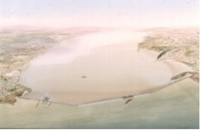Severn barrage could meet five per cent of UK energy needs
A consortium of UK engineering firms is proposing a barrage across the Severn estuary that could, it is projected, harness tidal energy to generate double the output of a nuclear power station.

When Tony Blair signalled last month that he would approve a new generation of nuclear power stations it was seen by many as a kick in the teeth for renewable power. Why bother, some asked, with the incremental benefits offered by wind turbines and solar cells when a few new nuclear power stations can supply all our needs and more? But while the ability of nuclear power to fulfil our spiralling demands is undisputed, the renewables ‘death knell’ is both premature and inaccurate. A consortium of UK engineering companies is proposing a multi-billion pound renewable project that, it claims, could generate 17TWh a year, meeting five per cent of our annual electricity demands.

The Severn Tidal Power Group (STPG), a consortium of engineers from Sir Robert McAlpine, Balfour Beatty, Taylor Woodrow and Alstom, is pushing for a 10-mile concrete barrage or dam that will stretch across the Severn estuary from Lavernock Point near Cardiff to Brean Down near Weston-super-Mare in Somerset. Claimed to be capable of double the output of a nuclear power station, the proposal is a fine example of how renewable power could compete in scale with nuclear. The group claims that the structure will exploit the unique tidal conditions of the Severn estuary, where a difference of 14m between high and low tides gives it the second highest tidal range in the world.
Register now to continue reading
Thanks for visiting The Engineer. You’ve now reached your monthly limit of premium content. Register for free to unlock unlimited access to all of our premium content, as well as the latest technology news, industry opinion and special reports.
Benefits of registering
-
In-depth insights and coverage of key emerging trends
-
Unrestricted access to special reports throughout the year
-
Daily technology news delivered straight to your inbox










Water Sector Talent Exodus Could Cripple The Sector
Maybe if things are essential for the running of a country and we want to pay a fair price we should be running these utilities on a not for profit...